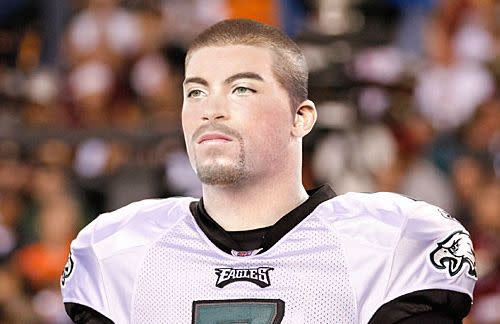 The Cutline
The CutlineESPN asks, ‘What if Michael Vick were white?’

What if Michael Vick were white?
That's the question ESPN The Magazine asks in its Sept. 5 issue, dedicated entirely to the Philadelphia Eagles quarterback.
"When Michael Vick plays," the column, by Brooklyn-based writer Touré, begins, "I see streetball. I don't just mean that sort of football where you have to count to four-Mississippi before you can rush the quarterback, nearly everything breaks down and it's all great fun. I also mean street basketball. Vick's style reminds me of Allen Iverson--the speed, the court sense, the sharp cuts, the dekes, the swag. In those breathtaking moments when the Eagles QB abandons the pocket and takes off, it feels as if he's thumbing his nose at the whole regimented, militaristic ethos of the game."
Touré continues: "All of that is why, to me, Vick seems to have a deeply African-American approach to the game. I'm not saying that a black QB who stands in the pocket ain't playing black. I'm saying Vick's style is so badass, so artistic, so fluid, so flamboyant, so relentless--so representative of black athletic style--that if there were a stat for swagger points, Vick would be the No. 1 quarterback in the league by far."
The provocative column included a photo illustration, commissioned by ESPN The Magazine, of what Michael Vick might look like if he were white.
Not surprisingly, the piece generated a blitz of discussion--and plenty of backlash--shortly after it was published online.
"In equally sensible questions," Matthew Darnell of Yahoo's Shutdown Corner wrote on Twitter, "what if Michael Vick was a black Tom Brady?"
"The 'White Vick' article seems pointless, stupid and forced," Fox Sports' Jason Whitlock wrote.
"Can't wait for the follow-up," Forbes.com's Jeff Bercovici tweeted. "What if Tom Brady had been born Asian, and a woman? In the 16th century?"
Touré, for his part, claims he did not come up with the art direction or the column's headline. "I did not suggest a title," he wrote in an email to The Cutline. "I'm not usually good at that but more that's not the writer's purview. In my long magazine experience writers don't suggest titles and aren't consulted about them. I happened to catch wind of the title and asked them to not use that but as you can see they didn't listen."
It appears that ESPN wavered, at least a little bit, as the URL uses a different headline: "Imagining Michael Vick as a white quarterback in the NFL." It also appears Touré--who was assigned the story by ESPN--was hesitant to explore the question, at least at first.
From the column itself:
Would a white football player have gotten nearly two years in prison for what Vick did to dogs? This question makes me cringe. It is so facile, naive, shortsighted and flawed that it is meaningless.
"They didn't tell me what to write," Touré wrote. "But I knew that if they wanted a football-intense piece they would've called one of the many experts they know so obviously I had to think about Vick from another context. But the Vick story is complex and allows you to look at it many ways."
He added: "My essay on Vick is nowhere near as inflammatory as the pic of him in whiteface which contradicts me saying you can't imagine him as white."
Reached by phone, the magazine's editor, Chad Millman, dismissed the notion that the column--and its title--were manufactured to generate a little controversy during the dog days of August.
"These are questions we've all been asking here," Millman told The Cutline. "What if he were a white quarterback? Would he have been treated differently? Would the reaction to the dogfighting case have been as angry or as polarizing? We're trying to lend answers."
Toure's column is part of what Millman called a "360-degree view of Vick," and the first-ever issue dedicated to one player.
Millman, though, acknowledged that Vick--who gave ESPN three months of exclusive access for the issue--is "a flashpoint for controversy."
"We think he's the best representative of what the NFL is today."
In his email, Touré--whose aptly titled book, "Who's Afraid of Post-Blackness? What It Means to Be Black Now" is scheduled to be published Sept. 13 by Free Press--acknowledged that several white quarterbacks, like Joe Namath and Fran Tarkenton, pioneered the type of play (flamboyance, scrambling) that signifies Vick's "deeply African-American approach to the game."
"Sure Vick didn't invent scrambling," Touré wrote. "His style reminds me of Steve Young as well as Randall Cunningham and Allen Iverson. I just see something in the way Vick moves when scrambling, his jukes and dekes and dancing, that says Black body language to me. Decoding athletes' body language is subtle stuff, the next person is free to disagree with me but his fluidity and his impulse to improvisation and the way he cuts through the field says African-American style to me."
